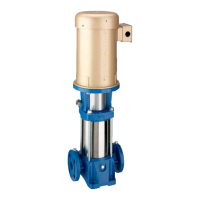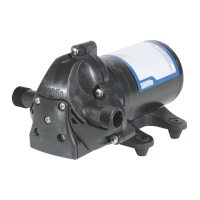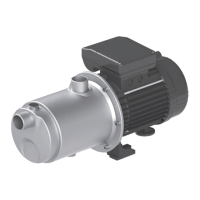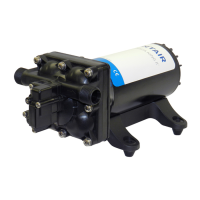6
MODELS 411 & 481, 412, 413 & 483
ISSASSEMBY OF A PUMP WITH MECHANICAL SEALS
1. Perform disassembly procedure as previously given
through step 8.
2. Loosen and remove four nuts (18) and washers (19) thus
freeing swing bolts (22) to allow shaft and impeller assembly
to be lifted from casing half (69) with sling and hoist or crane
as described in paragraph 10 above.
Use extreme care in moving this assembly, because sliding
loose on the shaft can crack ceramic seats. To prevent this,
wrap seal securely in a cloth to stop it from sliding on shaft.
3. With shaf
t and impeller assembly on a suitable bench, cra
dle, or work stand, loosen and remove pipe plug (12) from
inboard cartridge cap (42). Remove grease zerk (10) and cap
screws (41) and slide cartridge cap with grease seal (43) off
end of this shaft (65). Remove gasket (44)
4. Either pull or press bearing cartridge (45), grease seal (46)
and bearing (47) off shaft. Remove slinger (48).
5. The one piece gland (49) used with mechanical seal assem-
bly can now be removed from the shaft.
6
. O-ring (50 can be removed from seal gland if desired.)
7. Exercise great care in removing seal assembly (53) to keep
from marring or otherwise damaging precision ground mating
surfaces.
8. Scribe a mark on shaft sleeve for relocating seal collar on
reassembly. Loosen setscrews (55), securing seal collars (54)
to shaft sleeves and slide them off.
9. Proceed with further disassembly of outboard seal assem-
bly using the same procedure.
10. After removal of mechanical seals
, proceed with balance
of disassembly in same manner as described for packing
design.
REASSEMBLY
Reassembly will generally be in reverse order of disassembly.
If disassembly was not complete use only those steps related to
your particular repair program.
1. For Model 412, 413 & 483 pumps, reassemble base (77) to
casing half (69) with capscrews (76). Set these parts back on
their foundation and connect them to the suction and dis-
charge piping, then secure the base to its foundation by tight-
ening nuts on foundation bolts.
2. Position locating pins (67) in lower casing (
69), adding
swing bolt pins (68), if used on your pump. Install wearing
ring pins (66). Tap pins gently to seat them in place. If name
plate (71) was removed, install it with screws (70). Install o-
ring (62) in shaft sleeve
3. On right hand unit, thread inboard sleeve (64) onto shaft
(65) distance “A” (refer to figure 2). On left hand unit, thread
outboard sleeve (57) onto the shaft distance “A” (refer to fig
ure 3). When the sleeve is in position its keyway
should align with keyway o
n shaft. Coat key and keyway
with loctite sealant grade 242. Insert key (63) into keyways
of shaft and sleeve. Tap it firmly in place.
4. Coat inside diameter of impeller wearing rings (61)
(optional) with Loctite sealant grade 271 and press them over
hubs of impeller (59). Do not attempt to hammer impeller
wear rings into position, since they are press fit. Use of an
arbor press is preferred. However, placing a block of wood
over the impeller wearing ring and pressing it in will w
ork
satisfactorily. For power frames 5, 6B, and 7 only, two
setscrews (78) will be installed by drilling into wearing rings
and impeller. The opposite surface for the impeller should be
protected from damage throughout the procedures by resting
it against soft wood on the surface of workbench.
Impeller wearing ring must be given special care because the
press fit. Be sure rings are positioned squarely over the hub
of impeller. A softheaded hammer may be used to gently tap
impeller wearing rings into correct alignment before they are
pressed into place.
5. Coat impeller (59) keyway with loctite sealant grade 242
and slide onto shaft until it is firmly against the shaft sleeve.
Place o-ring (58) in shaft sleeve (57) and thread shaft sleeve
firmly against the impeller.
NOTE
When assembling rotation element of a 410 series pump,
it is
important than the curve of the impeller blades is in agree-
ment with pump rotation (see insert in figures 4, 5, and 6).
CAUTION
CAUTION
F. Impeller removed from outboard rotating element.
G. Removing bearing from shaft using conventional puller.
CAUTION
H. Shaft with sleeve and key in position.

